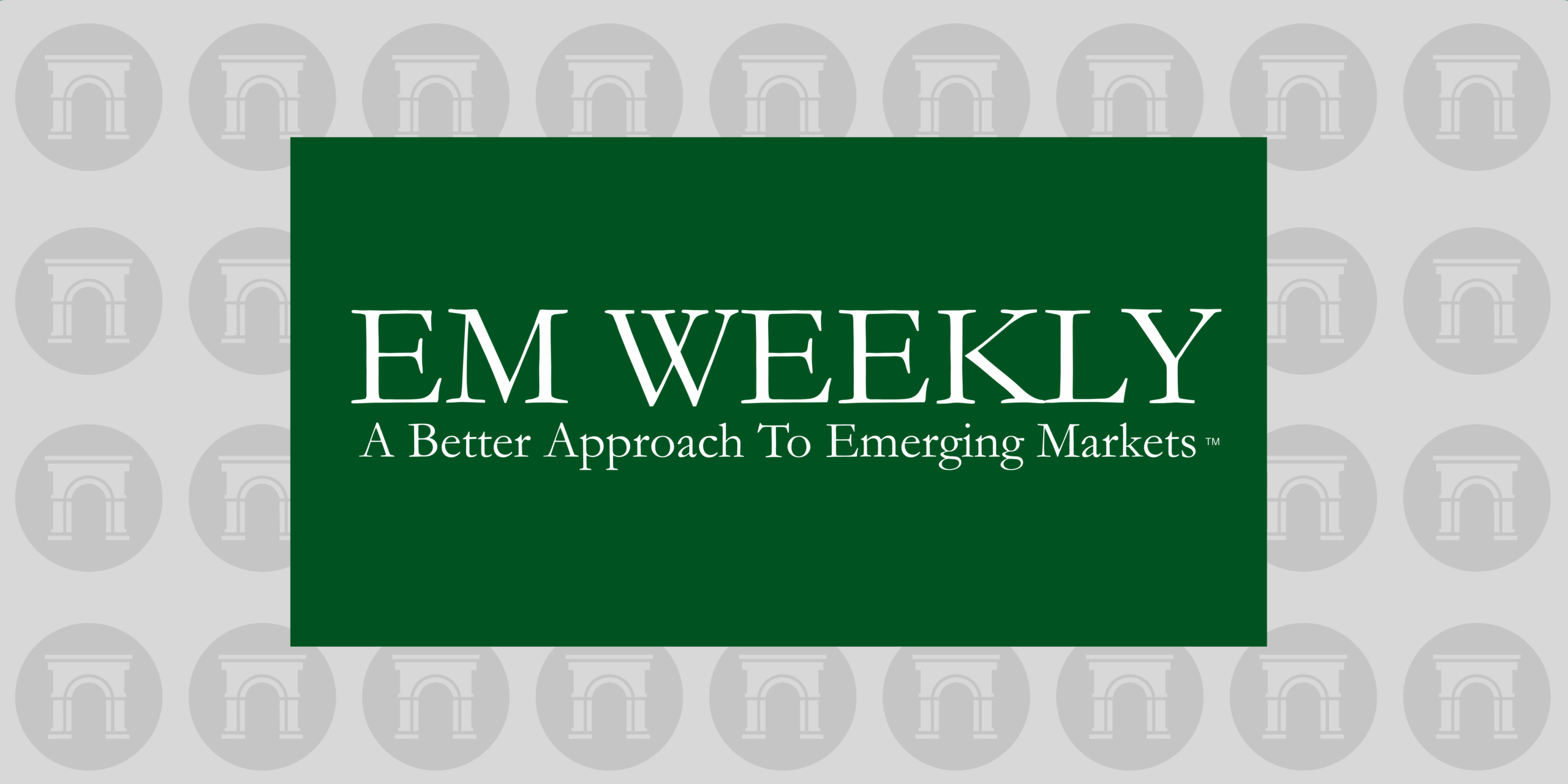Contents
Market Overview
Macro Update
This week global investors navigated an increasingly complex economic landscape defined by shifting monetary policy signals, evolving geopolitical dynamics, and notable market reactions.
The market swiftly priced in a September rate cut following last week’s significant downward revision in job numbers. Federal Reserve policymakers Neel Kashkari, Mary Daly, and Lisa Cook expressed concerns about the labor market and indicated that a rate cut might be appropriate in the coming months. Downside surprises in U.S. economic data persisted, with the ISM services index reporting a soft 50.1, below the market consensus of 51.5. Notably, the employment sub-component eased to 46.4, while the “prices paid” sub-index surged to a multi-year high of 69.9, exceeding expectations by 3.4 points. NY Fed 1-year inflation expectations ticked up from 3.02% to 3.09%. While not yet a dominant market narrative, these data points have nudged stagflation concerns back into investor conversations.
On Thursday, President Donald Trump appointed Stephen Miran to replace Federal Reserve Governor Adriana Kugler, who resigned effective August 8th. Mr. Miran, a key White House economic consultant and chair of the Council of Economic Advisers, is expected to advocate for lower rates. Should Mr. Miran secure rapid congressional approval ahead of the September 17th meeting, the focus of dissent may shift to the magnitude of the rate cut. Mr. Miran will serve until at least January 2026, when President Trump will appoint a permanent replacement, possibly one of the key contenders to replace Chair Jerome Powell in May 2026. Among the potential candidates to succeed Mr. Powell are Kevin Warsh and Kevin Hasset, though recent reports suggest Fed Governor Christopher Waller has emerged as the leading contender
Despite mixed economic signals and ongoing political noise at the Fed, equity markets rebounded, with the S&P 500 gaining nearly 1.6% as investors once again demonstrated a willingness to buy into weakness. Treasury markets ended the week roughly flat, with the 10-year yield at 4.28% and the 30-year at 4.86%. The dollar softened, with the DXY down approximately 1.0% on the week, while oil prices fell nearly 5% following OPEC’s announcement of its final supply increase under the current framework.
In Europe, economic data painted a more optimistic picture. Eurozone aggregate retail sales significantly outperformed expectations, growing by 3.1% year-over-year compared to the anticipated 2.6%. Additionally, the German Composite PMI exceeded forecasts, with the construction sub-index rising by 1.5 points, while weak industrial production was offset by strong sequential export growth. The euro strengthened over the week. Elsewhere in the region, the Bank of England lowered rates by 25bps in a 5-4 decision after an intermediate 4-4-1 split, bringing the policy rate to 4%, below the Fed’s policy rate, despite a recent uptick in inflation.
The U.S.’s new tariff regime went into effect this week, bringing the effective tariff level to more than 15%, up from 3% at the start of the year. Uncertainty remains, with continuing negotiations and ongoing secondary and sectoral sanction threats. India is set to face an additional 25% tariff penalty for its oil imports from Russia, bringing the cumulative tariff rate to 50%. Meanwhile, Switzerland’s president visited Washington in an attempt to reduce the country’s 39% tariff rate but was unsuccessful. Further tariffs on pharmaceutical and semiconductor products are anticipated. As companies’ inventories and cash buffers are drawn down, more challenging decisions will need to be made with respect to price pass-through and supply chain diversification.
On the geopolitical front, U.S. envoy Steve Witkoff met with Russian President Vladimir Putin ahead of President Trump’s August 8th deadline for a ceasefire. Following the meeting, President Trump alluded to plans to meet with Ukrainian President Volodymyr Zelenskiy and Mr. Putin as soon as next week. This comes as the U.S. administration intensifies secondary sanctions and pushes for more robust tanker restrictions to curtail Russia’s oil revenue and de-escalate the ongoing war in Ukraine. However, the bar for meaningful progress remains very high given the likely non-negotiable positions of the stakeholders.
EM Credit Update
Emerging market hard currency sovereign debt returned 0.69% this week, buoyed by strong risk appetite. High yield continued to lead performance, delivering 0.87%, compared to 0.51% for investment grade, as index-level spreads compressed by 12bps. The move was driven primarily by high-yield names, where spreads tightened 17bps vs. 8bps for investment grade.
Central Europe led regional returns, with Ukraine once again a top performer. Optimism around a potential Trump-Putin ceasefire meeting continued to lift Ukrainian bonds. Lebanon and Argentina also posted strong gains. In Lebanon, the cabinet formally tasked the military with drafting a plan to disarm Hezbollah by year-end – an initiative seen as a response to U.S. pressure and welcomed by markets. In Argentina, the IMF approved the first review of the country’s Extended Fund Facility, unlocking a $2 billion disbursement and easing reserve accumulation targets, both of which improved investor sentiment. In contrast, Zambia underperformed after the IMF’s updated Composite Indicator (CI) score fell slightly to 2.58, missing the 2.69 threshold required to trigger the bond’s upside payment scenario. This disappointed investors, who had priced in an upgrade by 2026.
Local currency debt advanced 1.19% on the week as renewed dollar weakness, driven by soft U.S. data and lower Treasury yields, supported EM foreign exchange. Colombia, Hungary, and Brazil led gains, with much of the performance coming from currencies. In Colombia, dovish signals from its central bank amid cooling inflation boosted bonds and foreign exchange. Hungary rallied alongside stronger-than-expected PMI data, while Brazil’s real recovered following political stability headlines. On the other hand, Chile and India lagged. In Chile, concerns over copper tariffs and the announcement of a new reserve accumulation program weighed on the peso, while higher tariffs pressured the rupee.
EM corporate bonds posted a more modest gain of 0.3%, with high yield again outperforming investment grade (0.41% vs. 0.22%). Spreads narrowed by 6bps, with similar tightening across ratings. Longer-duration assets outperformed, with the 10-year-plus segment returning 0.51%. Regionally, CEEMEA corporates led, supported by strength in Kazakh quasi-sovereigns, Ukrainian corporates, and metals and mining in Zambia.
Primary issuance was muted, with just one new deal. First Quantum Minerals priced a $1 billion 2034 note at 7.25%, attracting strong demand from cross-over accounts.
The Week Ahead
Key highlights in the U.S. next week include the release of CPI and PPI data, where slight increases are anticipated. These figures will be scrutinized for any signs of tariff pass-through. Additionally, jobless claims and average weekly and hourly earnings will be closely monitored, especially in light of last week’s significant revisions. Fed President Austan Goolsbee is scheduled to speak at an event on August 13th, which will be of keen interest to market participants amid shifting monetary policy signals.
Investors will also analyze the University of Michigan and small business optimism surveys to gauge sentiment, while retail sales data will provide insights into the health of the consumer. The budget balance will be in the spotlight amid ongoing fiscal deficit concerns.
Across the Atlantic, the eurozone and the UK are set to release their 2Q GDP, industrial production, and employment data. Meanwhile, the U.S.-China trade truce is set to expire on August 12th, but an extension is anticipated. In China, little change is forecasted for retail sales, industrial production, and property investment figures. Elsewhere in Asia, Japan will release its 2Q GDP and industrial production data, while India will publish its CPI and trade data.
On the monetary policy front, central banks in Thailand and Peru will hold rate decisions.
Fixed Income
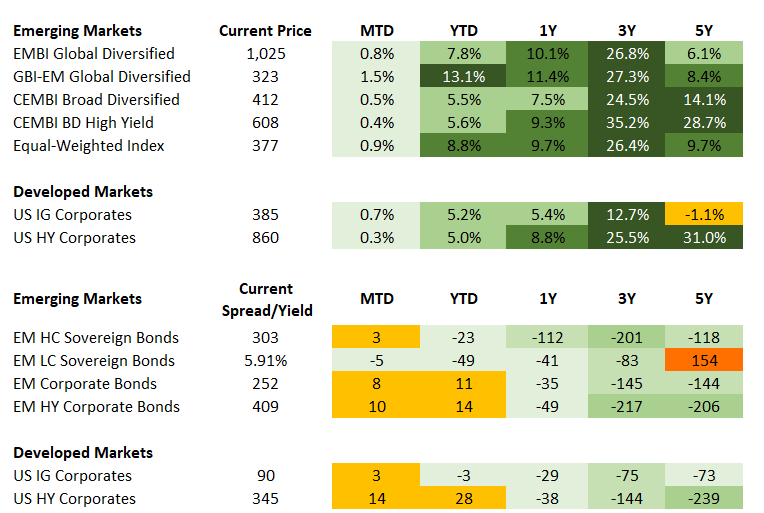
Equities
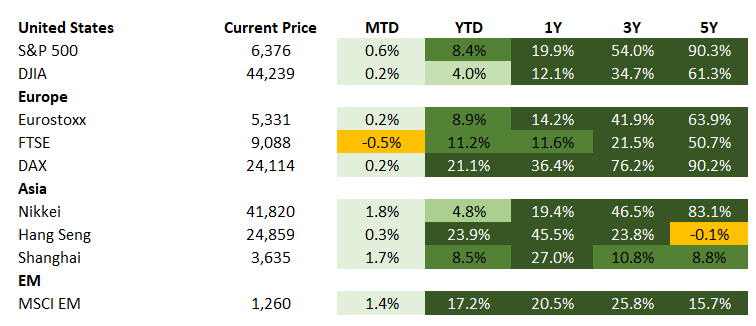
Commodities

Source for data tables: Bloomberg, JPMorgan, Gramercy. EM Fixed Income is represented by the following JPMorgan Indicies: EMBI Global, GBI-EM Global Diversified, CEMBI Broad Diversified and CEMBI Broad High Yield. DM Fixed Income is represented by the JPMorgan JULI Total Return Index and Domestic High Yield Index. Fixed Income, Equity and Commodity data is as of August 8, 2025 (mid-day).
Highlights
China Economic Resilience Continues to Prevail
Event: China’s exports rose 7.2% year-over-year in July compared to the consensus estimate of 5.6% year-over-year. This was led by exports to regions outside of the U.S. Exports to the U.S. declined by 21.7% year-over-year, while exports to the rest of the world rose 12.2% in the same time frame. Exports to emerging markets were strong across the board, led by a 42.4% year-over-year jump to Africa. Imports also surprised to the upside at 4.1% year-over-year, reflecting solid domestic demand. This followed robust S&P services PMI data of 52.6 vs. market consensus of 50.4. At the same time, Beijing and Washington continued to signal an upcoming extension of the trade truce.
Gramercy Comment: We see the continuation of solid economic data combined with prospects for an extended trade truce as underscoring China’s calibrated and patient approach to stimulus – as signaled during the recent Politburo meeting. Authorities will react accordingly to shore up growth to achieve their 5% target as activity data evolves or in the event of a negative policy surprise out of the U.S.
In the meantime, further efforts to support consumption and curtail select overcapacity will continue. While fresh tariff threats related to China’s imports of Russian oil remain possible in the short-term, we think this will ultimately be avoided as it would re-catalyze a tit-for-tat escalation to levels that have already proven to be intolerable for both sides. If the U.S. follows through on higher tariffs on China related to Russia, we expect the levies to be short-term in nature or to be integrated into broader trade discussions that appear set to extend into 4Q.
India Higher Tariff Likely Manageable
Event: The U.S. announced an additional 25% tariff on India as a penalty for the country’s oil imports from Russia, bringing the cumulative rate to 50%. While the 25% reciprocal tariff went into effect this week, the 50% level is set to go into effect in three weeks, providing a window for negotiation. At the same time, the Reserve Bank of India (RBI) held rates steady at 5.5% despite latest inflation data reaching a six-year low. The rupee stabilized amid renewed dollar weakness.
Gramercy Comment: The main impact of the higher tariff rate is on sentiment and growth. At a 50% tariff level, this leaves India less competitive relative to regional peers and will likely impede the country from benefiting from diversification investment in the region. However, India’s economy is comparatively closed and exports to the U.S. are small, at around 2% of GDP. As of July, the IMF expects India to grow at a robust 6.4% this year, an estimate that now likely faces moderate downside risk. On the external side, India’s current account deficit remains benign at around 1% of GDP, while foreign exchange reserves are robust at around $690 billion and above the IMF’s reserve adequacy metric. Looking ahead, we see room for further rupee stabilization as dollar headwinds prevail. This could re-open the door for easing of monetary policy later this year.
Pemex Financial Plan Unveils Additional $13 Billion Support Fund
Event: This week, President Claudia Sheinbaum, as well as the minister of finance, the secretary of energy, and the Pemex CEO, held two respective press conferences and presented further details with respect to Pemex’s financial plan. Mexican development banks, led by Banobras, will capitalize a new $13 billion vehicle, guaranteed by the Ministry of Finance, for Pemex to address supplier payments. This initiative, together with the previously launched $12 billion government-backed P-Cap vehicle, brings the company’s fresh liquidity relief to $25 billion this year, or roughly 1.4% of GDP. The plan entails reduction of Pemex debt to $77.3 billion by 2030 and aims for the company to fund and manage its financial liabilities from 2027 onwards.
Gramercy Comment: We see the additional facility as another constructive development that is demonstrative of the Mexican government’s strategic commitment to Pemex. It simultaneously aims to preserve the government’s balance sheet, notwithstanding growing but manageable contingent liabilities. The goal of Pemex’s self-sufficiency by 2027 is positive on the surface but the market will likely remain skeptical of this becoming a reality. As mentioned in our previous comment, the opportunity lies in how President Sheinbaum capitalizes on the space this fresh support affords: how she executes on the operational and strategic plan to further improve the firm’s liquidity position, enhance supplier payment practices, and foster an environment conducive to select private sector engagement. At the sovereign level, what will ultimately matter most is the government’s ability to balance stronger support for Pemex with broader economic imperatives.
Successfully navigating the balance between fiscal discipline, evolving trade dynamics, and the domestic investment climate will be critical as Mexico seeks to sustain macroeconomic stability and investor confidence.
Emerging Markets Technicals

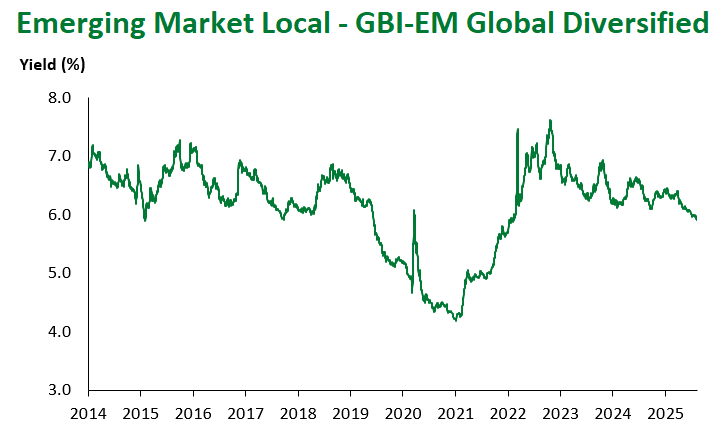

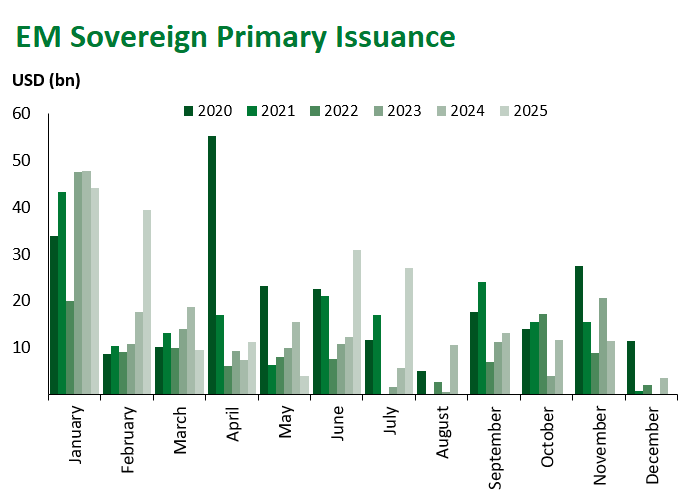
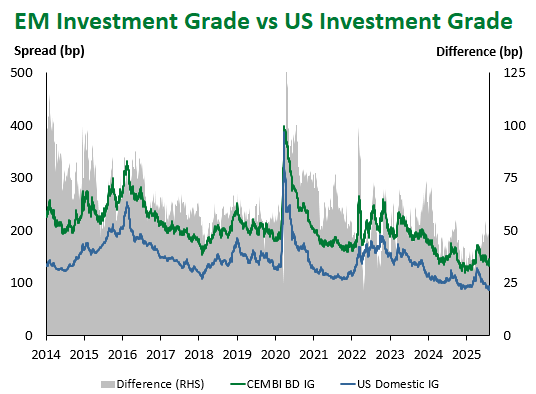

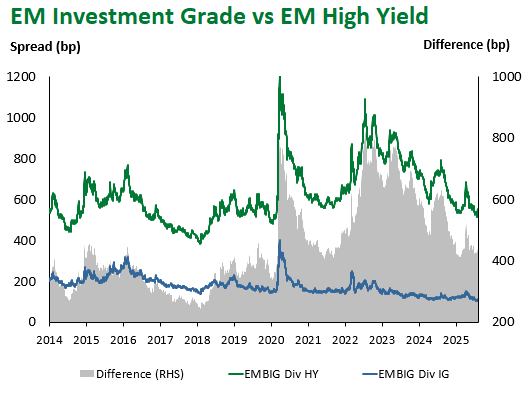
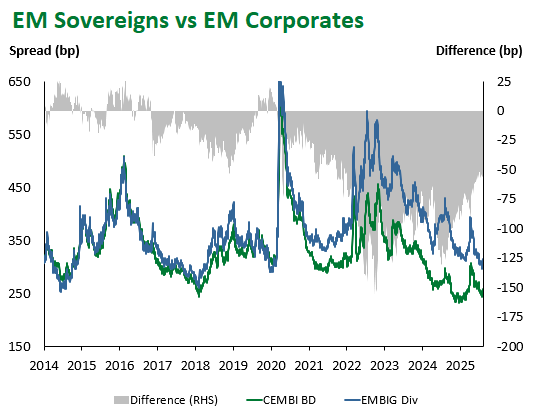
Emerging Markets Flows
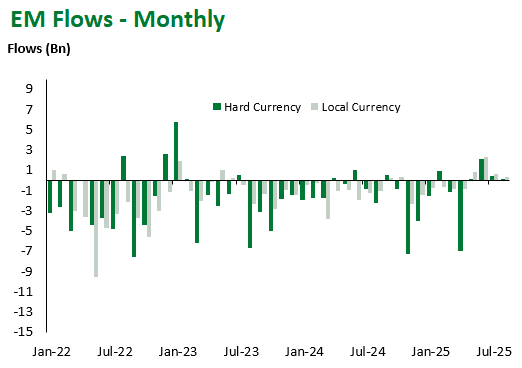
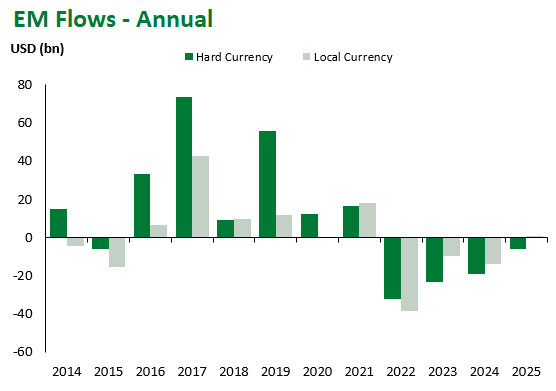
Source for graphs: Bloomberg, JPMorgan, Gramercy. As of August 8, 2025.
For questions, please contact:
Kathryn Exum, CFA ESG, Director, Co-Head of Sovereign Research, [email protected]
Petar Atanasov, Director, Co-Head of Sovereign Research, [email protected]
This document is for informational purposes only. The information presented is not intended to be relied upon as a forecast, research or investment advice, and is not a recommendation, offer or solicitation to buy or sell any securities or to adopt any investment strategy. Gramercy may have current investment positions in the securities or sovereigns mentioned above. The information and opinions contained in this paper are as of the date of initial publication, derived from proprietary and nonproprietary sources deemed by Gramercy to be reliable, are not necessarily all-inclusive and are not guaranteed as to accuracy. This paper may contain “forward-looking” information that is not purely historical in nature. Such information may include, among other things, projections and forecasts. There is no guarantee that any forecasts made will come to pass. Reliance upon information in this paper is at the sole discretion of the reader. You should not rely on this presentation as the basis upon which to make an investment decision. Investment involves risk. There can be no assurance that investment objectives will be achieved. Investors must be prepared to bear the risk of a total loss of their investment. These risks are often heightened for investments in emerging/developing markets or smaller capital markets. International investing involves risks, including risks related to foreign currency, limited liquidity, less government regulation, and the possibility of substantial volatility due to adverse political, economic or other developments. References to any indices are for informational and general comparative purposes only. The performance data of various indices mentioned in this update are updated and released on a periodic basis before finalization. The performance data of various indices presented herein was current as of the date of the presentation. Please refer to data returns of the separate indices if you desire additional or updated information. Indices are unmanaged, and their performance results do not reflect the impact of fees, expenses, or taxes that may be incurred through an investment with Gramercy. Returns for indices assume dividend reinvestment. An investment cannot be made directly in an index. Accordingly, comparing results shown to those of such indices may be of limited use. The information provided herein is neither tax nor legal advice. Investors should speak to their tax professional for specific information regarding their tax situation.
